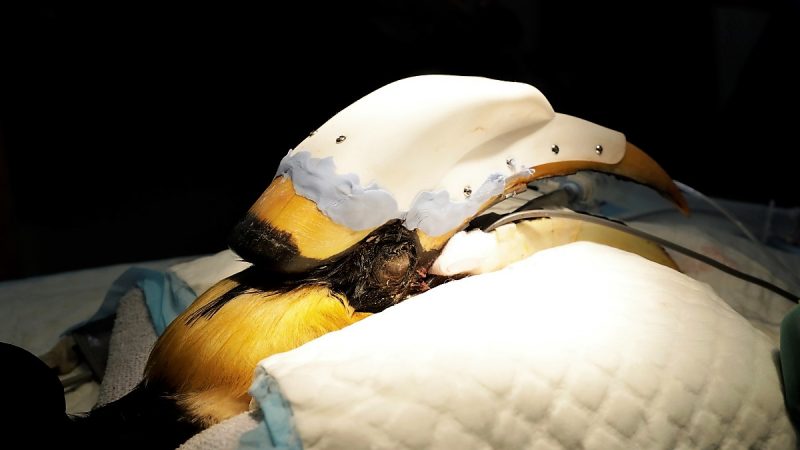It’s a reasonable certainty that 3D-printing is one day going to be a huge part of medicine. From hip implants to stents that prop open blood vessels to whole organs laid down layer by layer, humans will probably benefit immensely from medical printing. But if they do, the animals will get there first; somebody has to try this stuff out, after all.
An early if an unwilling adopter of 3D-printed medical appliances is [Jary], a 22-year-old Great Pied Hornbill, who recently received a 3D-printed replacement for his casque, the large, mostly hollow protuberance on the front the bird’s skull leading out over the upper beak. There’s no known function for the casque, but it had to be removed since cancer was destroying it and [Jary] wouldn’t have fared well post-surgically without one. Working from CT scans, the veterinary team created a model of the casque as well as a jig to guide the saw during surgery. There’s no word on what filament was used, but we’d guess PLA since it’s biocompatible and available in medical grades. The video below shows some of the surgery; it’s interesting to note that the prosthetic started out natural colored but quickly turned yellow as [Jary] preened with oils from glands near his tail feathers, just like a natural casque would.
Hornbills live to about 40 years old, so [Jary] is just middle-aged. Here’s hoping that he lives a long, happy life in return for being a pioneer in 3D-printing for medical and surgical appliances.
Thanks for another great tip, [baldpower].
















That is wonderfully amazing!
Kudos to all involved with saving the life of this magnificent creature.
Normally i’m in favor of giving cancer the bird, but this is far better.
Brilliant, great focus – hope it goes well, would like to see update in few weeks time ?
So much more we can do in health for all life, cleatly the most important thing of all is health if at least to advance our foundation for other diverse activities – what else could possibly be more important…
Thanks for post :-)
Wow! A whole new use for this 3D tool. Glad to see that the bird is doing well.
Nice job. It’s too bad they didn’t use (or couldn’t find) a resin that would look more natural than that gray stuff.
I think it is a rare case where the vets could have usefully collaborated with a car body-kit fitter.
But it is nice to see a repair in this throw-away world.
Look at the photos in the article linked, once the hornbill started preening the grayish printed material turned a very natural looking yellow.
I think we are both talking about the sealing resin used, not the PLA part.
Once again proving that being fit can simply mean befriending the right humans. We are both their savior and their destroyer… but mostly their destroyer. :-/
Indeed, cats have carved an entire ecological niche by being adorable as kittens. I am not quite sure where it went wrong for otters, those are even cuter. Perhaps its the smell of fish?
Seeing even just the preview image of the bird opened up is rough. It makes me think. As a hunter I’ve killed animals (quickly) and then prepared them for cooking and eating. (you can judge if you are vegan, otherwise….) Anyway, I can do that but cutting open a living animal (bird, human or otherwise) even sedated and with a positive intention to help it.. I’m not sure I would be capable of doing that. It makes me really appreciate surgeons and what they do.
Having performed surgery I feel very humble when I consider the marvel that is the human body.